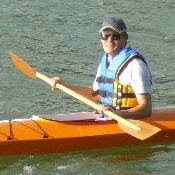I made a template for the hole by turning one of the plan sheets over and on the plain back marking the centre line, deck beam positions and the run of the cockpit stringers. I joined the tapering lines of the stringers with the curve of the dustbin lid at the aft end, and to an upturned bucket at the forward end. I transferred the curves to the kayak by punching through the paper with an awl. A little adjustment by eye was required to get a more pleasing line on the forward end before the line was followed by the jigsaw.
On the same day I prepared some pieces of ply, 120mm wide and 700mm long, cut across the outer grains of the ply (the way it bends easiest). I laid these pieces on the driveway with an old towel over the top and soaked them with boiling water. A few minutes later I filled the bucket that had acted as a template with sand and the wrapped the pieces (all stacked together) round the bucket and held them in place with a ratchet strap.
Two days later the ply was mostly dry and so I started to lay the curved pieces up on the kayak. I was originally going to make the coaming out of two thicknesses of the 4mm ply on end, wrapped aroung the inside edge of the cockpit cutout. This looked a little clunky though, so after mulling it over for a couple of days, I abandoned the inner layer.

So tonight I trimmed up the pieces with a jigsaw. I marked line parallel to the deck with an offset block then partially flattened out the curved end pieces to trim them. The straight side pieces were then trimmed to fit between the ends from ply with the outer grain running length ways. For the bottom edge, I marked the back of the coaming where it was level with the bottm edge of the cockpit stringers down the sides, and with the bottom of the deck beams on the fore and aft centre line. I faired a curve between the straight sides and the mid point and then cut it out hoping it would look OK when curved back on the boat. This shape has meant the a very deep section to the coaming at the aft edge, which was the intention since there is no real provision for a separate back rest in this kayak.
After a dry fit test I mixed up the epoxy, pre-wet each joint surface and primed out any parts that would be no longer accessible. I then added plenty of microfibres and used this to bong in the coaming. I held everything in place with temporary screws, and on the end joints between the side and end pieces I used broad packers (covered in plastic parcel tape) under the screw to cover the edge and keep the faces flush. The leftover epoxy and any squeeze out was then stuffed back into the gap between the deck and coaming to form a small fillet and improve the bond. Its definitely warming up here now and for the first time I noticed the pot of epoxy getting really hot in my hand as the curing reaction started to happen.

To finish the coaming of I will trim the edges into a fair curve and fit a lip the the upper, outer edge to take a spray skirt. I was going to use some steamed pine for this, but I think the curves are too severe to even bother trying. Instead I'll soak some 10mm rope in epoxy and pin it in place, then fair it in with filler while fairing the rest of the outer hull. And that's really all that is left to do. Tape the deck seam, fair it in along with the other external tapes and then sand and sand and sand, and then paint.

Oh, and there's also the small matter of making a paddle...






